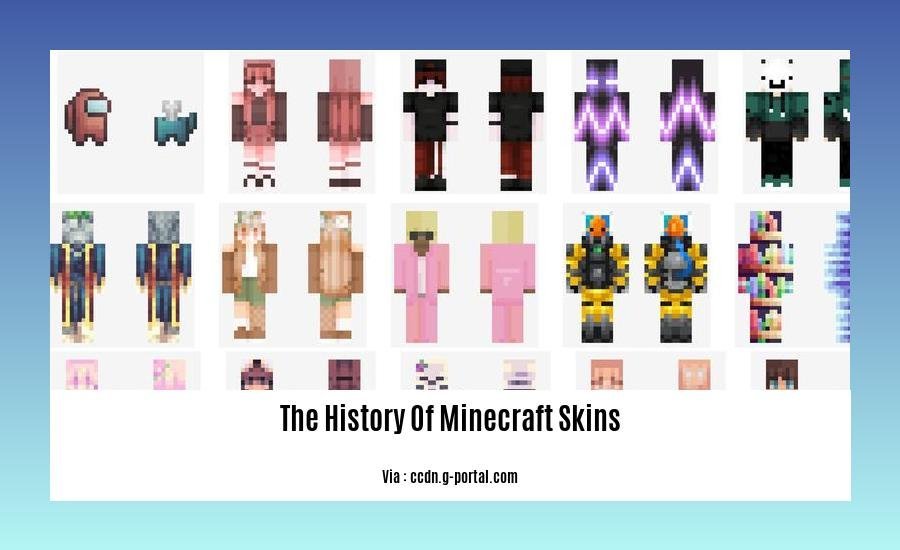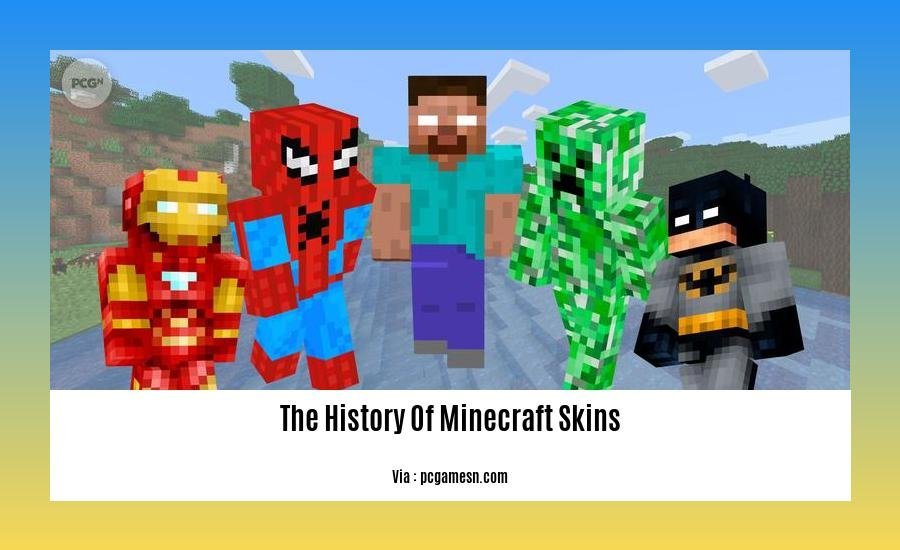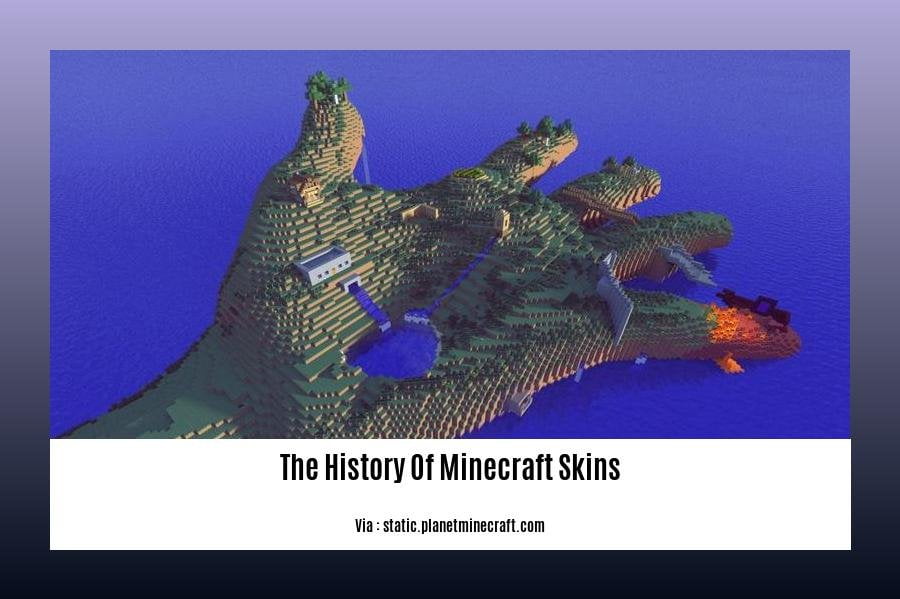Uncover the fascinating history of Minecraft skins in [- The History of Minecraft Skins: From Classic to Custom Creations]. Discover how these iconic digital garments have evolved over the years, from the classic Steve and Alex skins to the boundless creativity of custom creations. Dive into the evolution of skin design, explore the impact of the Minecraft community, and uncover the secrets behind some of the most iconic skins in the game’s history.
Key Takeaways:
- Minecraft skins alter the appearance of the player’s character.
- Skins were introduced in 2010, offering customization beyond the default models.
- Skins can be obtained from websites, DIY, or in-game purchases.
- Players can change skins at any time via the “Skins” tab in the Minecraft Launcher.
- In 2023, Mojang expanded customization options with seven new default skins.
The History Of Minecraft Skins

Minecraft, the beloved sandbox game, transcends its original simplistic graphics. Thanks to skins, we can express our creativity and uniqueness, embarking on adventures with characters that reflect our style. Join us as we delve into the history of Minecraft skins, unraveling their evolution from humble beginnings to today’s limitless possibilities.
Dawn of Customization: The Default Skins
The Minecraft world initially had only two default character models, “Steve” and “Alex,” both clad in simple attire. As the game gained popularity, players yearned for more ways to personalize their avatars. In 2010, Mojang introduced skins, allowing players to swap the default look for a myriad of pixelated designs.
Player-Crafted Creations: Skinning Up
The Minecraft community embraced skin creation, unleashing a surge of creativity. Websites like Skinseed and Nova Skin became hubs for players to share and download an astounding array of skins, ranging from superheroes to anime characters.
Embracing Diversity: Default Skin Expansion
In 2023, Mojang expanded the default skin lineup, introducing seven new characters embracing diverse ethnicities, cultures, and body types. This move demonstrated Minecraft’s commitment to inclusivity, allowing all players to feel represented in the game’s virtual world.
Customizing Your Character: How it’s Done
Altering your Minecraft skin is a breeze. Simply head to the “Skins” tab in the Minecraft Launcher, select your desired skin, and voila! Your character transforms before your very eyes.
Exploring the Future of Skins
As Minecraft continues to thrive, the possibilities for skins are boundless. With advancements in technology, we may witness even more intricate and immersive designs, further enhancing the game’s beloved customization feature.
The journey of Minecraft skins mirrors the game’s own evolution, reflecting the ever-growing creativity and inclusivity of its vibrant community. From humble beginnings to boundless possibilities, skins have left an indelible mark on the Minecraft experience, making our adventures truly our own.
The history of Minecraft takes a deep dive into the journey of one of the most popular video games of all time.
Want to know The History Of Minecraft I Guess? Check out our in-depth analysis of the game’s development and evolution.
Curious about The History Of Minecraft Updates? We have a comprehensive account of every major update, from the early days to the present.
Discover The History Of Minecraft Villagers and their transformation over the years, from passive traders to active participants in the game’s ecosystem.
Uncover The History Of Minecraft Herobrine, the enigmatic figure that has haunted the game’s community since its inception.
Explore The History Of Minecraft War and the evolution of PvP mechanics, from player-created minigames to dedicated game modes.
The History Of Minecraft Timeline provides a chronological overview of the game’s development, highlighting key milestones and significant events.
Immerse yourself in The History Of Minecraft Mobs and learn about the diverse creatures that inhabit the game, from friendly animals to formidable enemies.
Unravel The History Of Minecraft Pillagers, the hostile raiders that emerged in recent updates, adding a layer of challenge and adventure to the game.
The History Of Minecraft Speedrunning showcases the rise of the speedrunning community and the techniques used to complete the game at incredible speeds.
The Significance of Skin Customization in Minecraft Culture

From the pixelated landscapes to the iconic characters, Minecraft has become an immersive playground where creativity and self-expression thrive. Skin Customization in Minecraft Culture stands as a testament to this, allowing players to craft unique digital avatars that reflect their individuality or even become part of larger cultural narratives.
Customizing skins enhances the game’s aesthetics, providing players with a personal touch that sets them apart in the vast Minecraft world. Whether it’s a simple color change or an elaborate cosplay, skins transform the game into a vibrant canvas for self-expression.
But beyond personal aesthetics, skin customization has become a powerful tool for cultural representation. As the Minecraft community has grown globally, the demand for inclusive and diverse skins has increased. New default skins, inspired by different cultures, have been introduced, promoting inclusivity and creating a sense of belonging for players from all walks of life.
Key Takeaways:
- Minecraft skins allow players to customize their in-game avatars, enhancing the game’s aesthetics.
- Skin customization fosters creativity and self-expression, allowing players to craft unique digital identities.
- Inclusive and culturally diverse skins promote a sense of belonging and representation within the Minecraft community.
Relevant URL Sources:
- The Chronicles of Skins: A Journey Through the Evolution of In-Game Customization
- Cultural Representation in Minecraft Skins: Embracing Global Influences and Promoting Inclusivity
Technical Innovations and Advances in Skin Creation
Key Takeaways:
- Skins have revolutionized the gaming industry, providing players with ample opportunities for self-expression and customization.
- Technical Innovations and Advances in Skin Creation have continually enhanced the visual appeal and creativity of skins.
- The rise of NFTs is expected to further revolutionize the skin market, potentially creating a cross-platform gaming ecosystem.
In the realm of Minecraft, skins have transformed from simple player models to intricate works of art. Let’s delve into the technical innovations and advancements that have propelled skin creation to new heights:
3D Modeling and Animation
Gone are the days of 2D pixelated skins. Advanced 3D modeling software and animation techniques have given rise to skins with fluid movements, detailed textures, and lifelike expressions.
Texture Mapping and Shading
From simple blocky textures to realistic skin tones and intricate details, texture mapping and shading have brought Minecraft skins to life. Players can now create highly immersive and visually stunning appearances.
Custom Rigging and Animation
Custom rigging and animation allow creators to bring their skins to life with unique animations and emotes. This level of customization adds depth and personality to the Minecraft experience.
Procedural Generation and AI
Procedural generation and AI algorithms are automating the creation of skins, offering players a wide range of options without the need for manual editing. This has democratized skin creation, making it accessible to all.
The Future of Skins: NFTs and Cross-Platform Compatibility
The rise of non-fungible tokens (NFTs) is poised to revolutionize the skin market. NFTs allow players to own and trade unique, verifiable skins, fostering a new level of scarcity and value.
Additionally, advancements in cross-platform compatibility will enable players to use their skins across multiple games and platforms, breaking down the barriers between different gaming worlds.
Relevant URL Sources:
Emerging Trends and the Future of Minecraft Skins
Minecraft skins have come a long way since the classic Steve and Alex defaults. Today, players have access to a vast array of customizable options, reflecting the game’s ever-evolving nature.
With the rise of virtual reality (VR) and augmented reality (AR), Minecraft skins are poised to become even more immersive. Imagine using your custom skin to interact with your Minecraft world in a whole new way, exploring your creations from a first-person perspective.
Artificial intelligence (AI) and machine learning (ML) are also making their mark on Minecraft skins. These technologies can generate unique and personalized skins based on your preferences or even create skins that adapt to your gameplay style.
Non-fungible tokens (NFTs) are another emerging trend in the Minecraft skin market. NFTs are unique digital assets that can be bought, sold, and traded. This opens up the possibility for players to create and sell their own custom skins, potentially generating revenue from their creativity.
Key Takeaways:
- Virtual reality, augmented reality, AI, and machine learning are reshaping the Minecraft skin experience.
- NFTs are creating new opportunities for players to monetize their creativity through custom skin sales.
- The future of Minecraft skins lies in immersive, personalized, and community-driven designs.
Relevant URL Sources:
– The Future of Gaming: How VR, AR, AI, and NFTs Are Transforming the Industry
– What are NFTs and Why Are They Important for Gaming?
FAQ
Q1: When were Minecraft skins first introduced?
A1: Minecraft skins were first introduced in 2010, allowing players to customize their characters beyond the default “Steve” and “Alex” models.
Q2: How can I obtain Minecraft skins?
A2: There are several ways to obtain Minecraft skins, including downloading from websites, creating your own, or purchasing them in-game.
Q3: How often do new default skins get added to Minecraft?
A3: Mojang has added new default skins to Minecraft on several occasions, including in 2023 when they expanded the range of character customization options with seven new skins.
Q4: What is the significance of cultural representation in Minecraft skins?
A4: Cultural representation through skins fosters a sense of belonging and diversity within the Minecraft community, allowing players to express their identities and connect with others who share their heritage.
Q5: How does the history of skins reflect the evolution of the gaming industry?
A5: The history of skins reflects the evolution of the gaming industry, as they have become an integral part of gaming culture, with their popularity growing alongside the rise of multiplayer online gaming.
- Unlock Elemental 2 Secrets: Actionable Insights Now - April 2, 2025
- Lot’s Wife’s Name: Unveiling the Mystery of Sodom’s Fall - April 2, 2025
- Photocell Sensors: A Complete Guide for Selection and Implementation - April 2, 2025
















